Customer Journey Mapping
Journey mapping helps you visualize how customers experience your product or service, and how they feel along the way. Scroll to step 6 for a real-life example from one of our product teams!

USE THIS PLAY TO...
Understand the customer journey from a specific persona's perspective so that you can design a better experience.

Running the play
Depending on how many touchpoints along the customer journey you're mapping, you might break the journey into stages and tackle each stage in pairs.
Sticky notes
Whiteboards.io Template
Define the map's scope (15 min)
Ideally, customer journey mapping focuses on the experience of a single persona in a single scenario with a single goal. Else, the journey map will be too generic, and you'll miss out on opportunities for new insights and questions. You may need to pause creating a customer journey map until you have defined your customer personas . Your personas should be informed by customer interviews , as well as data wherever possible.
Saying that, don't let perfect be the enemy of good! Sometimes a team just needs to get started, and you can agree to revisit with more rigor in a few months' time. Once scope is agreed on, check your invite list to make sure you've got people who know the details of what customers experience when using your product or service.
Set the stage (5 min)
It's really important that your group understands the user persona and the goal driving their journey. Decide on or recap with your group the target persona and the scope of the journey being explored in your session. Make sure to pre-share required reading with the team at least a week ahead of your session to make sure everyone understands the persona, scope of the journey, and has a chance to delve deeper into research and data where needed. Even better- invite the team to run or attend the customer interviews to hear from customers first hand!
E.g. "We're going to focus on the Alana persona. Alana's role is project manager, and her goal is to find a scalable way for her team to share their knowledge so they spend less time explaining things over email. We're going to map out what it's like for Alana to evaluate Confluence for this purpose, from the point where she clicks that TRY button, to the point where she decides to buy it – or not."
Build a customer back-story (10 min)
Have the group use sticky notes to post up reasons why your target persona would be on this journey in the first place. Odds are, you'll get a range of responses: everything from high-level goals, to pain points, to requested features or services. Group similar ideas and groom the stickies so you can design a story from them.
These narratives should be inspired by actual customer interviews. But each team member will also bring a different perspective to the table that helps to broaden the lens.
Take a look at the example provided in the call out of this section. This back story starts with the pain points – the reasons why Alana would be wanting something like Confluence in the first place.
- E.g., "Her team's knowledge is in silos"
Then it basically has a list of requirements – what Alana is looking for in a product to solve the bottom pain points. This is essentially a mental shopping list for the group to refer to when mapping out the customer journey.
- E.g., "Provide structure"
Then it has the outcomes – goals that Alana wants to achieve by using the product
- E.g., "To keep my team focused on their work instead of distracted by unnecessary emails and shoulder-taps"
And finally the highest-level goal for her and her team.
- E.g., "Improve team efficiency"
Round off the back story by getting someone to say out loud what they think the overall story so far is, highlighting the main goals the customer has. This ensures a shared understanding that will inform the journey mapping, and improve the chances that your team will map it from the persona's point of view (not their own).
- E.g., "Alana and her team are frustrated by having to spend so much time explaining their work to each other, and to stakeholders. They want a way to share their knowledge, and organize it so it's easy for people outside their team to find, so they can focus more energy on the tasks at hand."

For example...
Here's a backstory the Confluence team created.
Map what the customer thinks and feels (30-60 min)
With the target persona, back story, and destination in place, it's time to walk a mile in their shoes. Show participants how to get going by writing the first thing that the persona does on a sticky note. The whole group can then grab stickies and markers and continue plotting the journey one action at a time.
This can also include questions and decisions! If the journey branches based on the answers or choices, have one participant map out each path. Keep in mind that the purpose of this Play is to build empathy for, and a shared understanding of the customer for the team. In order to do this, we focus on mapping the current state of one discrete end to end journey, and looking for opportunities for improvement.
To do a more comprehensive discovery and inform strategy, you will need to go deeper on researching and designing these journey maps, which will need to split up over multiple sessions. Take a look at the variation below for tipes on how to design a completely new customer journey.
Use different color sticky notes for actions, questions, decisions, etc. so it's easier to see each element when you look at the whole map.
For each action on the customer journey, capture which channels are used for the interactions. Depending on your context, channels might include a website, phone, email, postal mail, face-to-face, and/or social media.
It might also help to visually split the mapping area in zones, such as "frontstage" (what the customer experiences) versus "backstage" (what systems and processes are active in the background).
Journey mapping can open up rich discussion, but try to avoid delving into the wrong sort of detail. The idea is to explore the journey and mine it for opportunities to improve the experience instead of coming up with solutions on the spot. It's important not only to keep the conversation on track, but also to create an artefact that can be easily referenced in the future. Use expands or footnotes in the Confluence template to capture any additional context while keeping the overview stable.
Try to be the commentator, not the critic. And remember: you're there to call out what’s going on for the persona, not explain what’s going on with internal systems and processes.
To get more granular on the 'backstage' processes required to provide the 'frontstage' customer value, consider using Confluence Whiteboard's Service Blueprint template as a next step to follow up on this Play.

ANTI-PATTERN
Your map has heaps of branches and loops.
Your scope is probably too high-level. Map a specific journey that focuses on a specific task, rather than mapping how a customer might explore for the first time.
Map the pain points (10-30 min)
"Ok, show me where it hurts." Go back over the map and jot down pain points on sticky notes. Place them underneath the corresponding touchpoints on the journey. Where is there frustration? Errors? Bottlenecks? Things not working as expected?
For added value, talk about the impact of each pain point. Is it trivial, or is it likely to necessitate some kind of hack or work-around. Even worse: does it cause the persona to abandon their journey entirely?
Chart a sentiment line (15 min)
(Optional, but totally worth it.) Plot the persona's sentiment in an area under your journey map, so that you can see how their emotional experience changes with each touchpoint. Look for things like:
- Areas of sawtooth sentiment – going up and down a lot is pretty common, but that doesn't mean it's not exhausting for the persona.
- Rapid drops – this indicates large gaps in expectations, and frustration.
- Troughs – these indicate opportunities for lifting overall sentiments.
- Positive peaks – can you design an experience that lifts them even higher? Can you delight the persona and inspire them to recommend you?
Remember that pain points don't always cause immediate drops in customer sentiment. Sometimes some friction may even buold trust (consider requiring verification for example). A pain point early in the journey might also result in negative feelings later on, as experiences accumulate.
Having customers in the session to help validate and challenge the journey map means you'll be more confident what comes out of this session.
Analyse the big picture (15 min)
As a group, stand back from the journey map and discuss trends and patterns in the experience.
- Where are the areas of greatest confusion/frustration?
- Where is the journey falling short of expectations?
- Are there any new un-met needs that have come up for the user type?
- Are there areas in the process being needlessly complicated or duplicated? Are there lots of emails being sent that aren’t actually useful?
Then, discuss areas of opportunity to improve the experience. E.g., are there areas in the process where seven steps could be reduced to three? Is that verification email actually needed?
You can use quantitative data to validate the impact of the various opportunity areas identified. A particular step may well be a customer experience that falls short, but how many of your customers are actually effected by that step? Might you be better off as a team focused on another higher impact opportunity?
Here's a user onboarding jouney map our Engaging First Impressions team created.
Be sure to run a full Health Monitor session or checkpoint with your team to see if you're improving.
MAP A FUTURE STATE
Instead of mapping the current experience, map out an experience you haven't delivered yet. You can map one that simply improves on existing pain points, or design an absolutely visionary amazeballs awesome experience!
Just make sure to always base your ideas on real customer interviews and data. When designing a totally new customer journey, it can also be interesting to map competitor or peer customer journeys to find inspiration. Working on a personalised service? How do they do it in grocery? What about fashion? Finance?
After the mapping session, create a stakeholder summary. What pain points have the highest impact to customers' evaluation, adoption and usage of our products? What opportunities are there, and which teams should know about them? What is your action plan to resolve these pain points? Keep it at a summary level for a fast share out of key takeaways.
For a broader audience, or to allow stakeholders to go deeper, you could also create a write-up of your analysis and recommendations you came up with, notes captured, photos of the group and the artefacts created on a Confluence page. A great way of sharing this information is in a video walk through of the journey map. Loom is a great tool for this as viewers can comment on specific stages of the journey. This can be a great way to inspire change in your organization and provide a model for customer-centric design practices.
KEEP IT REAL
Now that you have interviewed your customers and created your customer journey map, circle back to your customers and validate! And yes: you might learn that your entire map is invalid and have to start again from scratch. (Better to find that out now, versus after you've delivered the journey!) Major initiatives typically make multiple journey maps to capture the needs of multiple personas, and often iterate on each map. Remember not to set and forget. Journeys are rapidly disrupted, and keeping your finger on the pulse of your customer's reality will enable your team to pivot (and get results!) faster when needed.
Related Plays
Customer Interview
Project Poster
Want even more Playbook?
Drop your email below to be notified when we add new Health Monitors and plays.
Thanks! Now get back to work.
Got feedback?
Drop a question or comment on the Atlassian Community site.
Shared understanding
Different types of teams need to share an understanding of different things.
LEADERSHIP TEAMS
The team has a shared vision and collective purpose which they support, and confidence they have made the right strategic bets to achieve success.
Proof of concept
Project teams.
Some sort of demonstration has been created and tested, that demonstrates why this problem needs to be solved, and demonstrates its value.
Customer centricity
Service teams.
Team members are skilled at understanding , empathizing and resolving requests with an effective customer feedback loop in place that drives improvements and builds trust to improve service offerings.
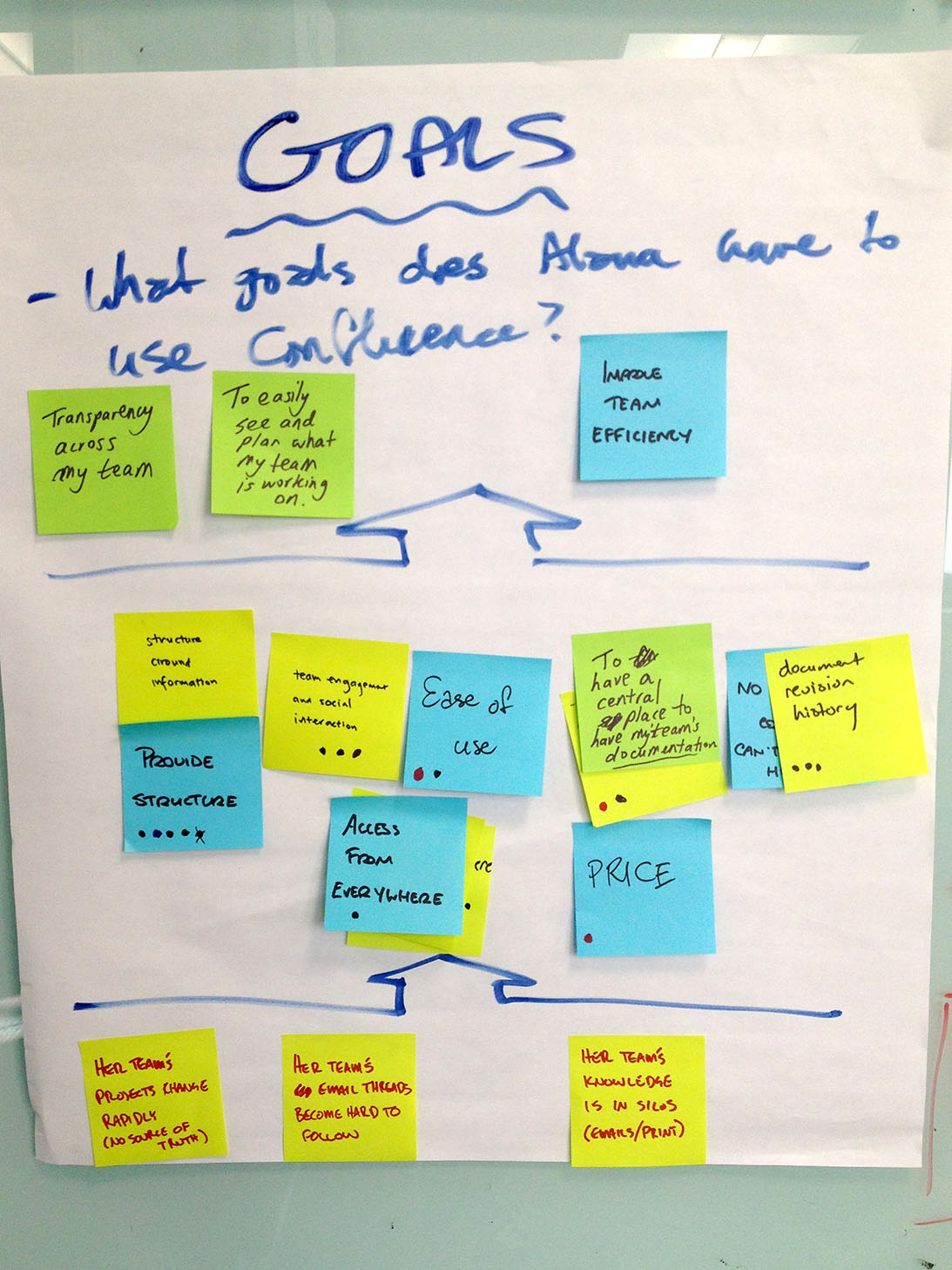

- Business & Money
- Marketing & Sales

Download the free Kindle app and start reading Kindle books instantly on your smartphone, tablet, or computer - no Kindle device required .
Read instantly on your browser with Kindle for Web.
Using your mobile phone camera - scan the code below and download the Kindle app.

Image Unavailable

- To view this video download Flash Player
Follow the author

The Journey Mapping Playbook: A Practical Guide to Preparing, Facilitating and Unlocking the Value of Customer Journey Mapping (De Gruyter Business Playbooks) Perfect Paperback – October 12, 2020
The Journey Mapping Playbook: A practical guide to preparing, facilitating and unlocking the value of customer journey mapping
A valuable guide in helping you build stronger customer experience programmes by developing effective customer experience strategies.
Customer journey mapping is a vital tool used by Customer Experience professionals around the world. The journey map is crucial in understanding and managing the customer's perception of your service or brand at critical touchpoints and prioritising how to improve that experience. Journey mapping also shows where great experiences currently exist within the company and how they should be celebrated or protected.
The danger in not journey mapping or getting it wrong is having no meaningful purpose and no consensus around what actions to take or why. At best, you risk wasting time, and effort or, at worst, handing your advantage over to your competitor.
What should a customer journey map envisage? How should you use it? And how do you plan, facilitate then demonstrate the value of journey mapping by providing a compelling argument within the organisation to make changes?
The Journey Mapping Playbook is an accessible how-to-do-it toolkit aimed at customer experience (CX) and marketing professionals who wish to improve their customer and employee experience. Jerry Angrave, a Customer and Passenger Experience Director who works across many sectors, including aviation and travel, financial services, professional services, and manufacturing, provides insight and practical guidance on planning, facilitating, and delivering a strategic journey mapping workshop.
In this playbook, you will learn how to: Define journey mapping; Understand why a journey map is commercially important; Prioritise which journeys to focus on and how; Decide whom to invite and which tools to prepare; Plan for an effective session; Make every stage of the journey relevant and purposeful; What to do at the output of the workshop to ensure you get the most out of them; Build an ongoing programme; Nurture better and more profitable customer experiences.
This book is for you if:
You are a customer experience or marketing professional; You are in the early stages of building a rewarding career in customer experience;
The Journey Mapping Playbook is a practical guide, presented in striking colour, with downloadable worksheets and frameworks to help you prepare, plan and run your workshop.
Events around the book
Link to a De Gruyter Online Event in which the author Jerry Angrave and founder & CEO of Empathyce, together with Ian Golding, Global Customer Experience Specialist; Sarah Corney, Head of Digital Experience, CIPD, London; and Nathalie Wickens, Customer Experience Manager, Cardiff Airport, discuss how business professionals can develop confidence with Customer Journey Mapping by making business decisions which are aligned with the experiences of the people they serve: https://youtu.be/s64kDe1dm2Y
- Print length 156 pages
- Language English
- Publisher De Gruyter
- Publication date October 12, 2020
- Dimensions 6.7 x 0.5 x 9.4 inches
- ISBN-10 3110641119
- ISBN-13 978-3110641110
- See all details

Similar items that may ship from close to you

From the Publisher

The Journey Mapping Playbook
A practical guide to preparing, facilitating and unlocking the value of customer journey mapping.
How do you plan, facilitate and then demonstrate the value of journey mapping by providing a compelling argument to make changes? This playbook will take you through not just the how-to of journey mapping in a way that you can then run your own sessions but we’ll also see where it fits in the wider context of Customer Experience.
Editorial Reviews
"Engages your attention from the very first page [...] makes for great, easy reading." --5-star review by The Bookbag
"Engages your attention from the very first page […] makes for great, easy reading." ― 5-star review by The Bookbag
About the Author
Jerry Angrave is Customer and Passenger Experience Director at Empathyce, a customer experience (CX) consulting and coaching company.
Jerry works across many sectors including aviation and travel, financial services, professional services and manufacturing. Based in the United Kingdom, he works with companies throughout Europe and the Middle East.
His work is about helping build stronger CX programmes through the development of effective CX strategies and the delivery of operational competencies. At its core is the understanding of customers; who they are, why they do business and their hopes, expectations and fears.
The value in customer journey mapping is therefore in unlocking the most important issues and prioritising what should be done about them. Jerry has facilitated hundreds of journey mapping workshops and trained countless CX practitioners to run their own sessions. He is a member of the Customer Experience Professionals Association, created in 2011 to support CX professionals globally. Jerry is hugely passionate about helping those who are looking to build a CX-based career to gain increased knowledge and confidence so they can contribute more to their organisation.
Jerry spent many years in senior CX roles with corporate organisations, including Lloyds Banking Group, before establishing Empathyce in 2012.
Product details
- Publisher : De Gruyter; 1st edition (October 12, 2020)
- Language : English
- Perfect Paperback : 156 pages
- ISBN-10 : 3110641119
- ISBN-13 : 978-3110641110
- Item Weight : 14.6 ounces
- Dimensions : 6.7 x 0.5 x 9.4 inches
- #734 in Customer Relations (Books)
- #4,388 in Marketing (Books)
About the author
Jerry angrave.
Discover more of the author’s books, see similar authors, read author blogs and more
Customer reviews
Customer Reviews, including Product Star Ratings help customers to learn more about the product and decide whether it is the right product for them.
To calculate the overall star rating and percentage breakdown by star, we don’t use a simple average. Instead, our system considers things like how recent a review is and if the reviewer bought the item on Amazon. It also analyzed reviews to verify trustworthiness.
- Sort reviews by Top reviews Most recent Top reviews
Top review from the United States
There was a problem filtering reviews right now. please try again later..
An Ultime Guide to User Journey Mapping

Craig Douglas
- March 28, 2024
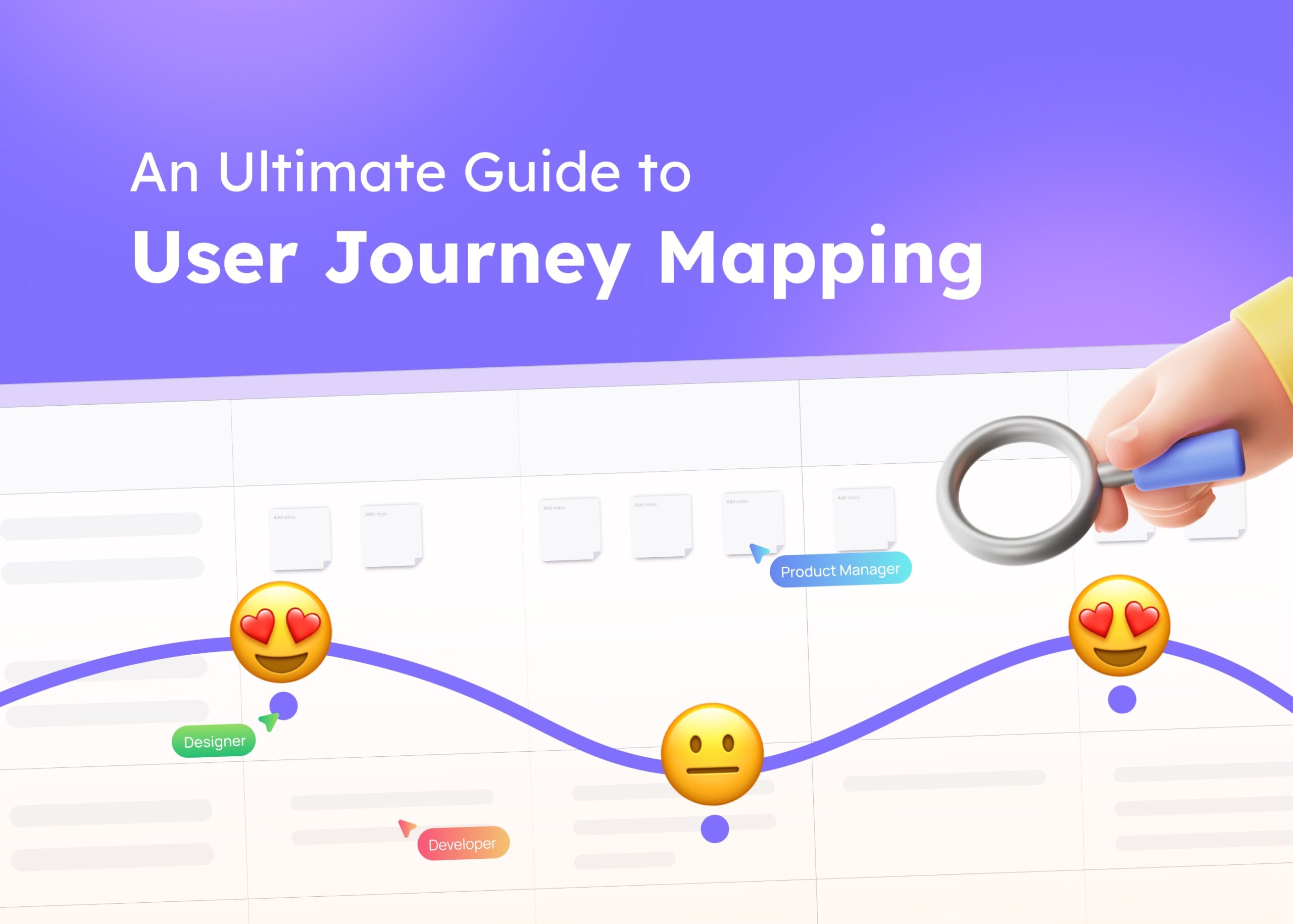
TABLE OF CONTENT
Share this post.
User journey mapping is a powerful tool that helps businesses understand and improve the customer experience. By visually representing the customer journey, companies can identify key interactions, or touchpoints, where customers engage with their brand. This process involves detailed user research to gather insights into customer behavior, preferences, and challenges. Customer journey mapping aims to pinpoint pain points—areas where customers may encounter frustration or obstacles. By recognizing these pain points, businesses can work to enhance customer journeys, making them smoother and more enjoyable. This, in turn, can lead to increased customer satisfaction and loyalty. In this guide, we will delve into the essentials of customer journey mapping. Let’s get started!
What is a user journey map?
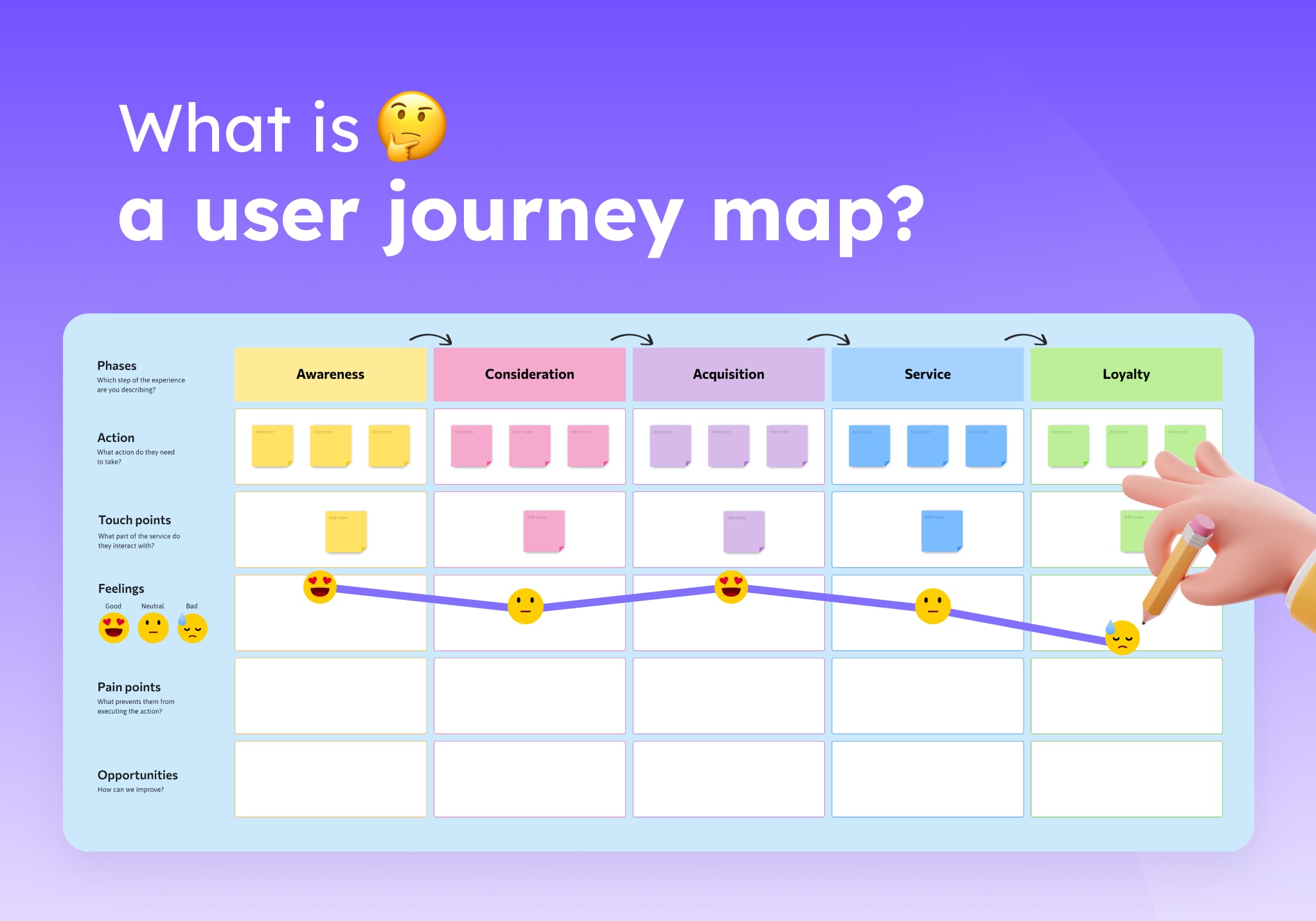
A user journey map is a visual representation of a customer’s experience as they interact with a product, brand, or service. It’s like a roadmap that shows the path of a customer’s experience with a brand, highlighting key touchpoints where they engage with the company’s services or products. These maps are not just simple charts; they are detailed and customer-focused, often created using customer journey map templates to ensure all relevant aspects are included. The process of creating a customer journey map starts with user research and customer interviews. This helps to understand the different stages and journey phases that customers go through. By mapping out these stages, businesses can identify customer pain points and areas where customers might feel frustrated or have a negative experience. Service blueprint maps can also be integrated into the journey map to provide an even deeper understanding of the service teams’ roles in the customer journey. User personas, which represent the different types of customers, are used to tailor the map to specific customer needs and expectations. This ensures that the journey map is relevant to the actual users. UX journey mapping, a subset of customer journey mapping, focuses on digital interactions and user behavior online. Businesses can make informed decisions to improve customer retention, loyalty, and overall success by analyzing the customer’s journey. Whether it’s a physical store or an online platform, a well-crafted customer journey map is a strategic asset in enhancing the customer base’s experience.
Why Create User Journey Maps?
Now, let’s explore the reasons why creating user journey maps is a beneficial practice for businesses aiming to understand and serve their customers better.
Understanding the Digital Customer Experience
In the digital world, a customer journey map provides a clear picture of how customers interact with a product or service online. It lays out the sequence of digital touchpoints and actions that customers take as they aim to fulfill a need or complete a task. Creating user journey maps allows businesses to step into their customers’ shoes and see their products from the user’s perspective, leading to a more empathetic approach to design and service.
Identifying Pain Points and Opportunities
One of the main reasons to create a customer journey map is to identify pain points within the digital experience. These are moments where a user might feel confused, frustrated, or dissatisfied. By pinpointing these areas, a business can focus on making improvements that will have the most significant impact on customer satisfaction and loyalty. Additionally, journey mapping can reveal opportunities to enhance the user experience or introduce new features that meet customer needs.
Improving Customer Success and Retention
A well-designed user journey map helps businesses understand and streamline the journey stages, leading to improved customer success. When users can navigate a digital product with ease and achieve their goals without unnecessary friction, they are more likely to continue using the product and recommend it to others. This can increase customer retention and turn users into advocates for the brand.
Tailoring Experiences with Customer Personas
Customer personas are characters that represent different segments of a business’s customer base. By using personas in journey mapping, companies can create multiple journey maps that cater to the unique needs and expectations of various user groups. This tailored approach ensures that the digital product resonates with a broader audience and meets the diverse requirements of prospective customers.
Planning for the Future with Service Blueprints
Service blueprints are detailed plans that outline the processes and systems needed to deliver a digital product or service. When combined with user journey maps, they provide a comprehensive view of both the customer’s experience and the internal operations that support it. This dual perspective is crucial for planning future enhancements and ensuring that the team has the resources and internal ownership necessary to implement changes effectively.
Collaborating and Communicating Across Teams
Journey mapping is a collaborative initiative that brings together team members from different departments. By visualizing the user’s journey, everyone from designers to service teams can understand their role in shaping the customer experience. This shared understanding fosters better communication and collaboration, leading to a more cohesive and customer-focused approach to product development. Creating user journey maps is a strategic step for any business with a digital product. It provides a deliberate and brief description of the user’s emotional state, actions, and interactions with the product. By using journey maps, businesses can ensure that their digital offerings are not only functional but also enjoyable, leading to a loyal customer base that continues to grow.
What are the Elements of a User Journey Map?
To effectively create a user journey map for a digital product, it’s essential to understand the core elements that make up this strategic tool. Each element plays a crucial role in providing a comprehensive view of the customer’s interaction with the product. Let’s explore these elements in detail.
A persona represents a segment of your user base. It’s a detailed character sketch of an ideal user, based on real data and user research. Personas help you understand who you are designing for and what their specific needs, goals, and behaviors are. When crafting a user journey map, start by selecting a persona to focus on, whether they are current users or a target audience you wish to attract. This will guide the entire mapping process, ensuring that the insights are relevant and actionable.
The scenario outlines the specific interaction or experience you are mapping. It could be a real user interaction that has been observed or an anticipated one that you expect to occur in the future. Scenarios help to set the context for the journey map, defining what the user is trying to achieve and why. For a digital product, scenarios might include signing up for a service, making a purchase, or seeking customer support.
Stages of the Journey
The journey is broken down into high-level phases or stages, which represent the major steps the user goes through in the scenario. These stages might include discovery, consideration, decision, and post-purchase or retention. Each stage is a milestone in the user’s journey with your digital product, and understanding these can help you design a more intuitive and user-friendly experience.
User Actions
Within each stage, identify the specific actions that the user can take. This could be anything from clicking a button, filling out a form, or navigating through different pages of your website or app. By mapping out these actions, you can pinpoint where users might encounter difficulties or where the flow can be optimized for better efficiency.
User Emotions and Thoughts
As users interact with your digital product, they experience a range of emotions and thoughts. Mapping these out can provide valuable insights into the user’s emotional state at each stage of the journey. It helps to identify moments of frustration, confusion, or satisfaction, which can inform how you design the user interface and overall experience.
Opportunities
Opportunities are areas where you can improve the user experience (UX) of your product or create a more effective connection with your customer. By analyzing the journey map, you can uncover gaps in the user experience or features that could be added to meet user needs better. These opportunities are the key to innovating and staying ahead of the competition.
Internal Ownership
Finally, it’s important to assign internal ownership for each part of the journey. This means identifying which team or team member will be responsible for implementing changes and improvements based on the journey map. Having clear ownership ensures that insights from the journey mapping initiative are acted upon, leading to tangible improvements in the customer experience.
How to Create a User Journey Map with Visily
Creating a user journey map is a strategic step in understanding and improving the customer experience with your digital product. Visily is a tool that can help streamline this process. Here’s how you can use Visily to create your own user journey map:
- Sign up for Visily and create your project.
- Once you’re in your project, you can start designing from scratch using Visily’s blank canvas. This gives you the freedom to structure the user journey map exactly how you want it.
- If you prefer to work with a guide, Visily offers a library of templates. These templates are pre-designed maps that you can choose from, saving you time and providing inspiration for your map.
- Whether you’re starting with a blank canvas or a template, you can customize your map using Visily’s smart components and sticky notes. Visily allows you to add details, such as different stages of the journey, and user actions, in an organized and visually appealing way.
After your user journey map is complete, sharing it with team members or stakeholders is easy. Visily allows you to share your map directly from the platform, facilitating collaboration and feedback.
User journey mapping is a crucial step toward enhancing the digital customer experience. It allows businesses to visualize and understand the customer’s path, identify pain points, and uncover opportunities for improvement. By incorporating personas, scenarios, stages, actions, emotions, and internal ownership, journey maps become a blueprint for customer-focused innovation. Visily is an excellent tool for creating user journey maps, offering a user-friendly platform with templates and smart components. Beyond journey mapping, Visily also supports wireframing and prototyping, making it a versatile choice for designing digital products. By using Visily, teams can collaborate effectively, ensuring that every member contributes to a seamless user experience. For businesses looking to improve their digital offerings, Visily is the right place to start. Try Visily today, and take the first step in crafting a digital experience that delights your customers and sets your brand apart.
Visily— AI-Powered Wireframing & Design
Related Articles
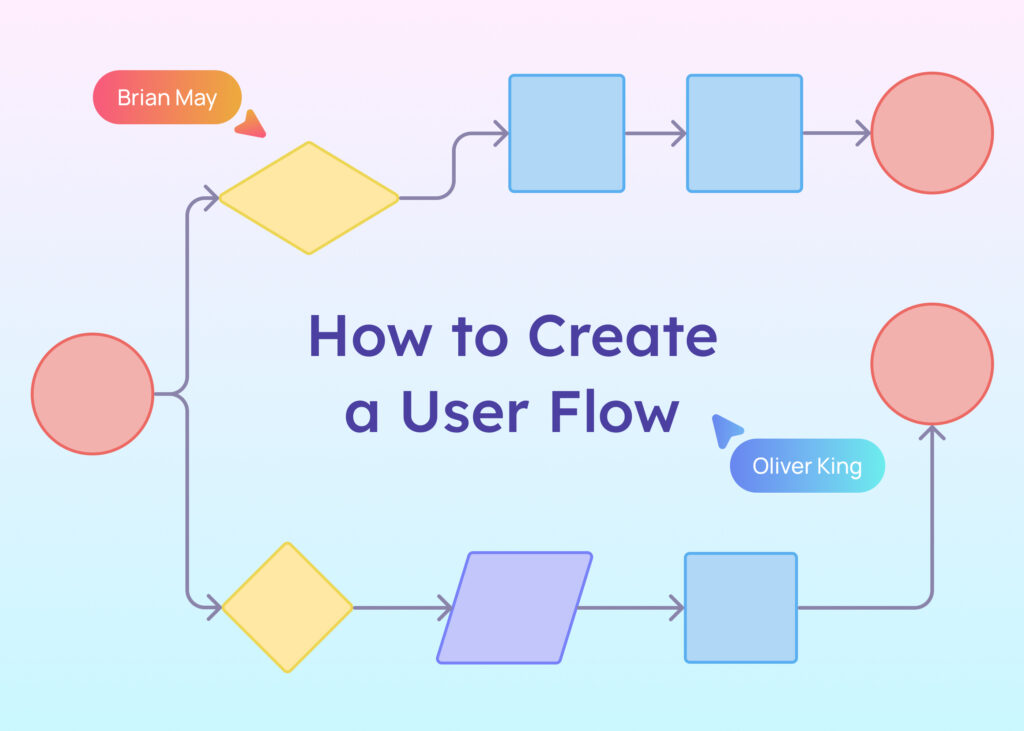
How to Create a User Flow

How To Learn UX Design (A Guide for Beginners)

15 Fundamental UX Design Principles All Designers Should Know

Why is UX Design Important?
![What is a UX Design Strategy? [+ 5 Steps to Make One] What is a UX Design Strategy_ [+ 5 Steps to Make One]](https://www.visily.ai/wp-content/uploads/2024/01/What-is-a-UX-Design-Strategy_-5-Steps-to-Make-One-1024x731.jpg)
What is a UX Design Strategy? [+ 5 Steps to Make One]
Subscribe to Visily now
Don’t miss out on the latest articles to stay a top of UX design and Product management
Thank you for subscribing! You'll be kept updated with our monthly newsletter. Stay tuned!
Hey 👋, check us out
- Wireframing
- Prototyping
- Collaboration
- Brainstorming
- Built-in Templates
- Hi-fidelity Mockups
- Components Library
More about us
- Help Center
- Explore Visily
- Release Notes
- Pressing Room
- Careers Join us!
- Privacy Policy
- Terms Of Service
© 2024 Visily. All rights reserved.
© 2024 Visily, Inc. All rights reserved.

The Journey Mapping Playbook:
The Journey Mapping Playbook is an accessible how-to toolkit aimed at customer experience and marketing professionals looking for ways to improve customer and employee experience. Using visualisation, templates and case studies this is a practical guide to planning, facilitating and delivering a strategic, supportive and effective journey mapping workshop.
##What is The Journey Mapping Playbook?
The Journey Mapping Playbook is a book by Jerry Angrave. It is an essential guide for UX Designers, UX Researchers, and other design professionals who are looking to become more experienced with journey mapping. The book provides a wealth of information, including an overview of journey mapping, expert guidance on various practical approaches, and innovative solutions to common challenges.
##What Can Designers Learn From this Book?
Designers can learn about the basics of journey mapping, as well as more complex approaches. The book also provides advice on how to collect journey map data, interpret key insights, and create solutions that meet customer needs. Additionally, tools and techniques are explored extensively, so that designers can both understand the process and learn from examples.
##Key Focus Areas
The Journey Mapping Playbook covers the following focus areas:
-Journey mapping fundamentals
-Data collection
-Designing for effective journeys
-Storytelling and storytelling design
-Experiential designing
-Making customer journey maps actionable
-Facilitating journey maps with stakeholders
-Improving old journeys and crafting new journeys
-Experimenting with journeys and understanding customer journeys
-Developing new venture opportunities with journey maps
-Finalizing customer journey maps with touchpoint optimisation.
Understand your customers better with a journey map

Related Tips
Learn ux design, 30% off in all courses, check out design engineering handbook a must-read for designers, get a designer's business mindset., create research based sitemaps, challenge yourself, sharpen your skills and get ahead., need a quick solution, why not sprint, find perfect images for presentations in a quick way, products for designers.
Useful Collections for Designers and Design Addicts
ELLIE -Notion for your CV&Portfolio
Hi there, I'm Ellie. As a Notion file with customizable templates, I help designers like you create standout CVs and portfolios with ease. Whether you're sharing your professional experience, showcasing case studies, or introducing yourself, I'm here to make the process simple, intuitive, and enjoyable. Best of all? I'm completely free. Let's take your design career to the next level together.
The Benefits of Ellie
Prepare a standout CV and portfolio Customizable templates to showcase your unique style and skills Create a professional introduction and share your work with ease Completely free - no hidden costs or fees!
With Ellie,
you'll have all the tools you need to take your design career to the next level. Whether you're just starting out or looking to revamp your current portfolio, Ellie has everything you need to create a professional and polished online presence.
So why wait?
Try Ellie today and see the difference it can make for your design career.
.png)
Same with a Delicious Coffee Price
30 Days UX Design Challenges
Improve your design skills in a specific area, Real-world design problems, Complete a portfolio, Understand the UX design process Access challenges and resources for a whole monthIt's only the cost of a cup of coffee!
Get All the Best UX Design Challenges for the Cost of a Cup of Coffee!
Are you ready to level up your UX design skills? Look no further than our 30-day UX design challenge. With a new challenge for each day of the month, you'll be pushed to think creatively and outside of the box as you tackle real-world design problems. Each challenge is designed to improve a specific aspect of your UX design skills, from user research to wireframing and prototyping. By the end of the 30 days, you'll have a stronger understanding of the UX design process, and a portfolio of completed challenges to showcase your newfound skills.
The Benefits of This Incredible Challenges
Improve your design skills in a specific area Real-world design problems Complete a portfolio Understand the UX design process Access to challenges and resources for a whole month It's only the cost of a cup of coffee!
Get your hands on this incredible Challenges today and improve for your UX Design skills!
.png)
Designer Practice List
Get your hands on this incredible Practice List today and start creating like a pro.
Get All the Best Practices for the Cost of a Cup of Coffee!
Having the right practices is essential for any creative professional. Practicing your skills regularly can help you stay sharp and up-to-date with the latest trends, as well as help you become more efficient at your craft. With this Practice List, you'll have access to over 100 curated practices, including games, case studies, and templates, all for the cost of a cup of coffee. Get your hands on this incredible Practice List today and start honing your skills like a pro.
The Benefits of This Incredible Practice List
This Practice List is an essential resource for all creative professionals. Here are the incredible benefits of having this List:
- It's useful for all creative professionals, not just designers.
- You'll get the list both in Notion and Airtable.
- It includes over 100 curated practices, including games, case studies, and templates.
- It's constantly updated, so you always have access to the latest and greatest.
- It's only the cost of a cup of coffee!
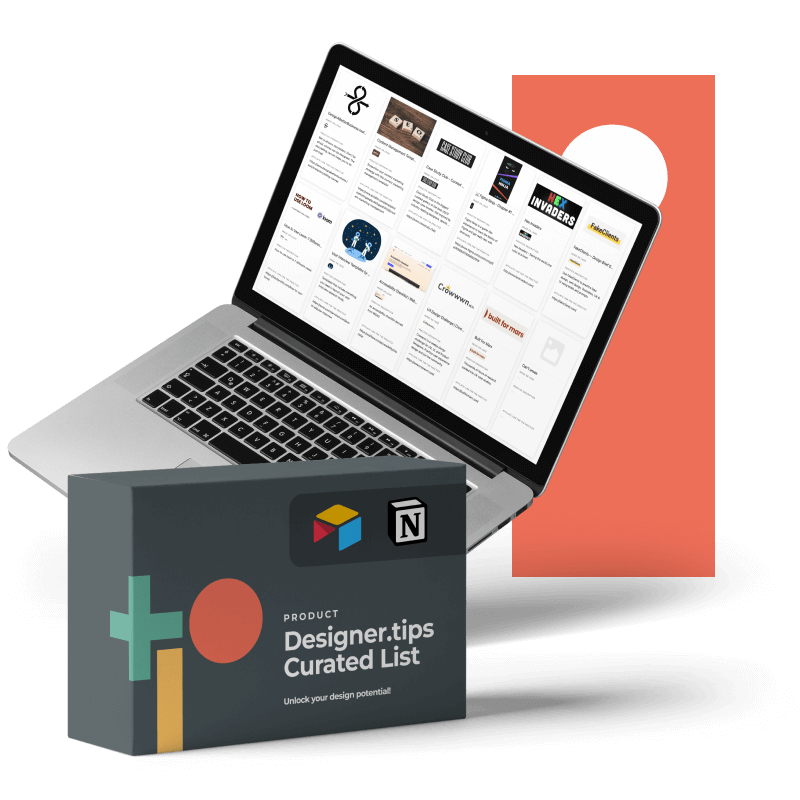
Designer Intro Courses List
We have curated useful resources in the form of videos, courses and articles for you to learn from the right source.
Get the Best Introduction Courses for the Cost of a Cup of Coffee!
Having a good introduction course is essential for any creative professional. It gives you the resources you need to get started, and the knowledge to stay updated and current with the latest trends and tools. Plus, it's an inexpensive way to learn like a pro and access the best courses available. Get your hands on this incredible List today and start learning like a pro!
The Benefits of This Incredible List
This List is an essential resource for all creative professionals. Here are the incredible benefits of having this List:
- It includes over 100 introduction courses.
Get your hands on this incredible List today and start learning like a pro.

Designer Tool List
We are living in “there is a tool for that” era. We have curated many tools that will reduce the time you spend on work and allow you to do more creative work.
Create Like a Pro with These Tools for Just the Cost of a Cup of Coffee!
This Notion Pack is a must-have for all creative professionals! With over 100 tools, including design tools, AI tools and productivity tools, you'll always have the resources you need to make your projects a success. Plus, it's constantly updated, so you'll always have access to the latest and greatest. And, the best part? It's only the cost of a cup of coffee! Get your hands on this incredible Notion pack today and start creating like a pro.
The Benefits of This Incredible Notion Pack
This Notion Pack is an essential resource for all creative professionals. Here are the incredible benefits of having this list:
- It includes over 100 tools, including design tools, AI tools and productivity tools.
Get your hands on this incredible Notion pack today and start creating like a pro.


Subscribe Our E-mail List
Follow us on, be a member of designer.tips, reach out at [email protected].

Complete Guide to Creating a Customer Journey Map
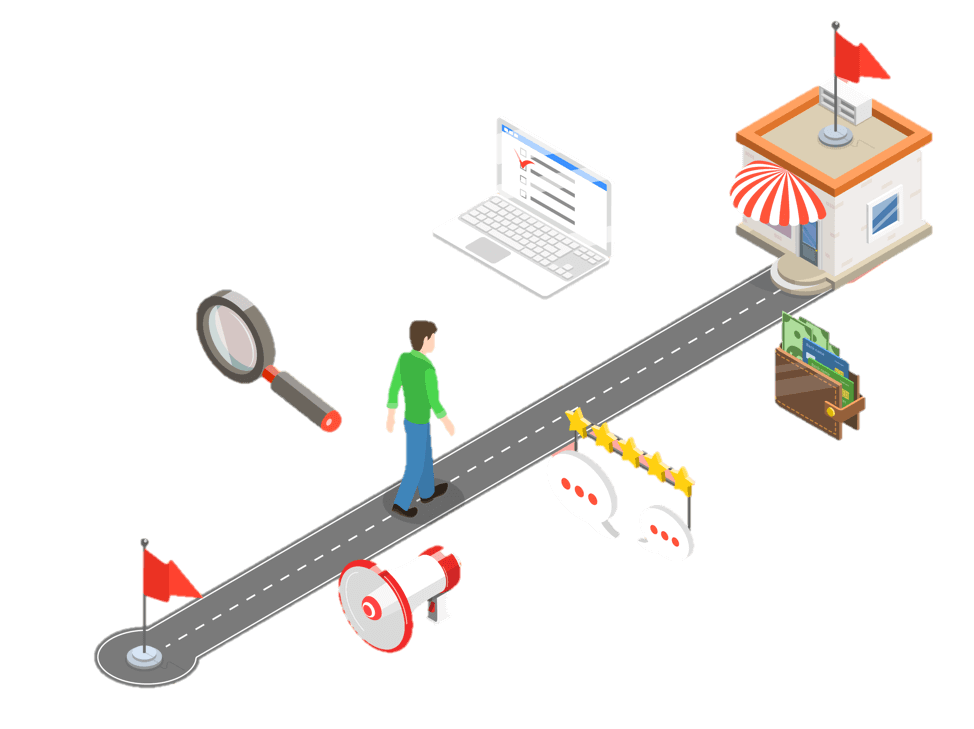
Conducting a customer journey mapping workshop does a few key things. It facilitates a common understanding between team members, uncovers insights from the user’s journey and explores potential opportunities for growth and improvement.
In order to make your customers happy and build products that solve real problems, you need to understand what users are experiencing when they come into contact with your product or service.
Current State vs. Future State Customer Journey Maps
There are two types of customer journey maps: a current-state customer journey map and a future-state customer journey map. The current-state journey map visualizes the user’s current experience with your product or service, while the future-state journey map visualizes the user’s future experience.
Before beginning, you should define the scope of the customer journey map. You will most likely want to start out at a very high level and review the whole customer experience.
For example, a high-level customer journey map outlines the process of taking a flight from discovering the user needs to go on the trip, to booking the trip, to boarding the plane and finally the billing process.
A fully detailed customer journey map can give a deeper level of user insights by outlining the entire experience on the plane. You will map out when the user first boarded the plan, how they found their seat, the in-flight announcements, snack service and finally the baggage claim process.
In this post, we are going to focus on a high-level, end-to-end customer journey map.
Preparing for the Customer Journey Mapping Workshop
Prior to starting the workshop, you want to make sure you have a few things prepared to make it successful.
Identify the primary persona
It is important that the group has a primary persona in mind. When working in user experience design it is important to focus on one primary user. Other disciplines like marketing will have many personas, each having different demographics and characteristics that they can target.
Gather as much research as you can and make sure everyone in the room is briefed on the latest research. You can pull information from previous customer satisfaction surveys, support logs, analytics, competitive intelligence and any other previous customer research that you have conducted. Everyone involved should have a good base understanding of the customer you are creating the journey for. If you are starting without any research, we would recommend you do some research first to guide the conversation. You can conduct moderated interviews , unmoderated interviews, contextual inquiries , surveys, diary studies etc.
Assemble your team
You want people representing all functional areas of the business including development, design, marketing, and operations to join the session. This will be different for each product or service but think about the key areas of business. Ideally, you want a comprehensive team but you don’t want more than 8 people since it can derail productivity.
Prep the materials
It is often helpful to have a template to guide the workshop. There are multiple different templates that you can use but most of them have relatively the same components and will get the job done. It will also be helpful to have a big whiteboard or a print out of the template to stick on a wall. Also, during the workshop, give everyone in the room a pad of sticky notes and a sharpie.
Customer Journey Map Template
The customer journey map template is a large grid. Here is a link to download a blank template so you can fill it out during your session. The top of the grid, outlines the different stages the customer goes through while engaging with your product or service.
Across the Top of the Template
1. awareness.
This is when the customer is trying to learn about the potential solutions to their problems and recognize they have a need.
2. Researching
This is when the customer is researching potential solutions. This varies widely by product. With some products, customers make instant purchasing decisions while with other products customers spend hours researching the options since there may be high switching costs.
3. Selection
This is when the customer makes the conscious decision to use the product.
4. Delivery
Once the user has selected the product, this describes how they receive it.
5. Follow Up
What follow up does the company do after the customer has consumed the product or service? In this box, make sure to focus on your company’s retention strategy. The goal is to push users into being an advocate of your product .
Down left side of the Template
This is what the customer is doing during each of the above stages. What are the customers actual behaviors and actions?
2. Thinking
Try to understand what the customer is thinking. What are their thoughts, feelings, motivations and needs at each stage?
3. Touch points
These are the points of interaction between the user and the product or company. Is there specific communication or messaging to reference? Is that communication through a mobile app or website?
4. Customer Pains
What things do we know are pains for the user at each stage of the process. Our goal is to address those pains and to fix them in future designs.
5. Customer Gains
These are things that are currently delighting the customer. They are things that make them happy. Ideally, we want to keep doing these things as you continue to improve the product .
6. Opportunities
This is a summary of the problems and questions customers have. Identify potential opportunities where you can deliver better service. These are your action steps coming out of the customer journey mapping session. They will drive your product roadmap.
Role of the Facilitator
As the facilitator, you should start by having the group brainstorm, using the boxes as guidelines, starting with the awareness box. The group can write out each activity on a sticky note and paste it in the corresponding box on the customer journey map template .
You should keep moving box by box until you finish the journey map. As the facilitator, you want everyone to work together and feed off one another.
Following the workshop, you should capture everything written on the sticky notes into a shareable document.
Remember, the customer journey map is a living document and it should evolve and change as the product or service matures. Make sure to display the output in a prominent place to be referenced often.
Download a free customer journey template here
Usability testing methods
International user testing
Idea validation
User Research
Moderated interviews
Unmoderated user research
User research recruiting
Prototype testing
Usability testing
Concept testing
UX research
User Testing Templates
First Impressions Test
Brand Perception Questions
Competitor Testing Questions
Concept Testing Questions
Persona Interview Questions
Website Navigation Menu
Logo Testing Questions
Pricing Model Test
Company Name Test
Start getting user feedback today

- Architecture and Design
- Asian and Pacific Studies
- Business and Economics
- Classical and Ancient Near Eastern Studies
- Computer Sciences
- Cultural Studies
- Engineering
- General Interest
- Geosciences
- Industrial Chemistry
- Islamic and Middle Eastern Studies
- Jewish Studies
- Library and Information Science, Book Studies
- Life Sciences
- Linguistics and Semiotics
- Literary Studies
- Materials Sciences
- Mathematics
- Social Sciences
- Sports and Recreation
- Theology and Religion
- Publish your article
- The role of authors
- Promoting your article
- Abstracting & indexing
- Publishing Ethics
- Why publish with De Gruyter
- How to publish with De Gruyter
- Our book series
- Our subject areas
- Your digital product at De Gruyter
- Contribute to our reference works
- Product information
- Tools & resources
- Product Information
- Promotional Materials
- Orders and Inquiries
- FAQ for Library Suppliers and Book Sellers
- Repository Policy
- Free access policy
- Open Access agreements
- Database portals
- For Authors
- Customer service
- People + Culture
- Journal Management
- How to join us
- Working at De Gruyter
- Mission & Vision
- De Gruyter Foundation
- De Gruyter Ebound
- Our Responsibility
- Partner publishers

Your purchase has been completed. Your documents are now available to view.
The Journey Mapping Playbook
A practical guide to preparing, facilitating and unlocking the value of customer journey mapping.
- Jerry Angrave
The publication that you have attempted to download requires a license.
Customer Journey Mapping
Guidelines for customer journey mapping, step 1: set the stage.
Define a single persona in a single scenario with a single goal. Decide on or recap with your group the target persona and the scope of the journey being explored in your session.
Step 2: Build a back-story
Have the group use sticky notes to post up reasons why your target persona would be on this journey in the first place. Odds are, you'll get a range of responses: everything from high-level goals, to pain points, to requested features or services. Group similar ideas and groom the stickies so you can design a story from them.
Step 3: Map what the persona thinks and feels
Show participants how to get going by writing the first thing that the persona does on a sticky note. The whole group can then grab stickies and markers and continue plotting the journey action by action, one action per sticky.
This can also include questions and decisions! If the journey branches based on the answers or choices, have one participant map out each path.
Sometimes user journeys involve more than one channel for interaction, and this could be important for your group to capture. For each action on the journey, ask what channel(s) are involved, and write them as initials on that sticky. Depending on your context, channels might include a website, phone, email, postal mail, face-to-face, and/or social media.
It might also help to visually split the mapping area in zones, such as "on-stage" (what the customer experiences) versus "back-stage" (what systems and processes are active in the background).
Journey mapping can open up rich discussion, but try to avoid delving into the wrong sort of detail. The idea is to explore the journey and mine it for opportunities to improve the experience instead of coming up with solutions on the spot. Try to be the commentator, not the critic. And remember: you're there to call out what’s going on for the persona, not explain what’s going on with internal systems and processes.
Step 4: Map the pain points
Go back over the map and jot down pain points on sticky notes. Place them underneath the corresponding touchpoints on the journey. Where is there frustration? Errors? Bottlenecks? Things not working as expected?
For added value, talk about the impact of each pain point. Is it trivial, or is it likely to necessitate some kind of hack or work-around? Even worse: does it cause the persona to abandon their journey entirely?
Step 5: Chart a sentiment line
(Optional, but totally worth it.) Plot the persona's sentiment in an area under your journey map, so that you can see how their emotional experience changes with each touchpoint. Look for things like:
Areas of sawtooth sentiment — going up and down a lot is pretty common, but that doesn't mean it's not exhausting for the persona.
Rapid drops — this indicates large gaps in expectations, and frustration.
Troughs — these indicate opportunities for lifting overall sentiments.
Positive peaks — can you design an experience that lifts them even higher? Can you delight the persona and inspire them to recommend you?
Remember that pain points don't always cause immediate drops in customer sentiment. Consider whether a pain point early in the journey might result in negative feelings later on.
Step 6: Analyze the big picture
As a group, stand back from the journey map and discuss trends and patterns in the experience.
Where are the areas of greatest confusion/frustration?
Where is the journey falling short of expectations?
Are there any new unmet needs that have come up for the user type?
Are there areas in the process being needlessly complicated or duplicated? Are there lots of emails being sent that aren’t actually useful?
Then, discuss areas of opportunity to improve the experience. E.g., are there areas in the process where seven steps could be reduced to three? Is that verification email actually needed?
- Product Management
- Research & Design

Submit your template →
Do you have a great board to share with the world? We' ll help you turn it into a template to share with the community.
Similar templates
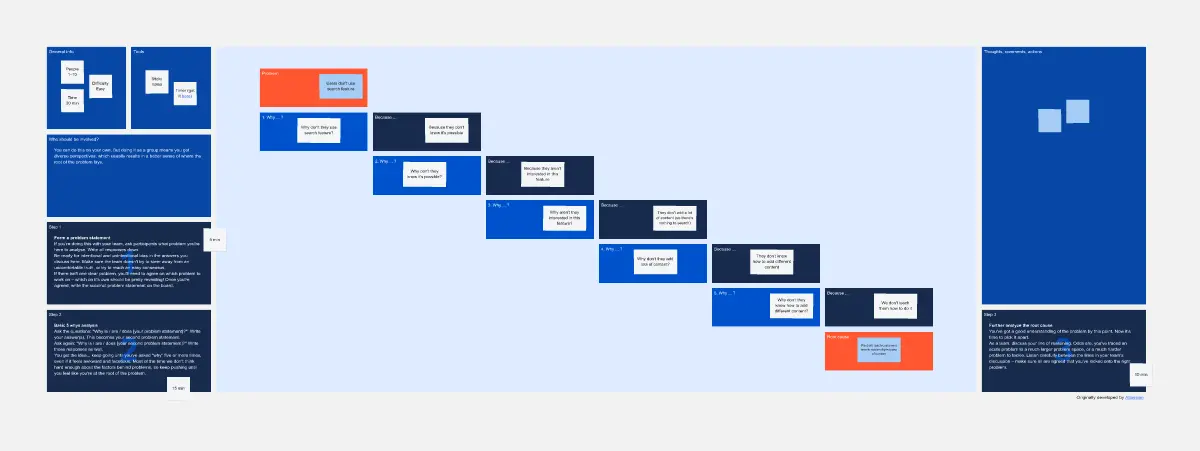
5 Whys Analysis
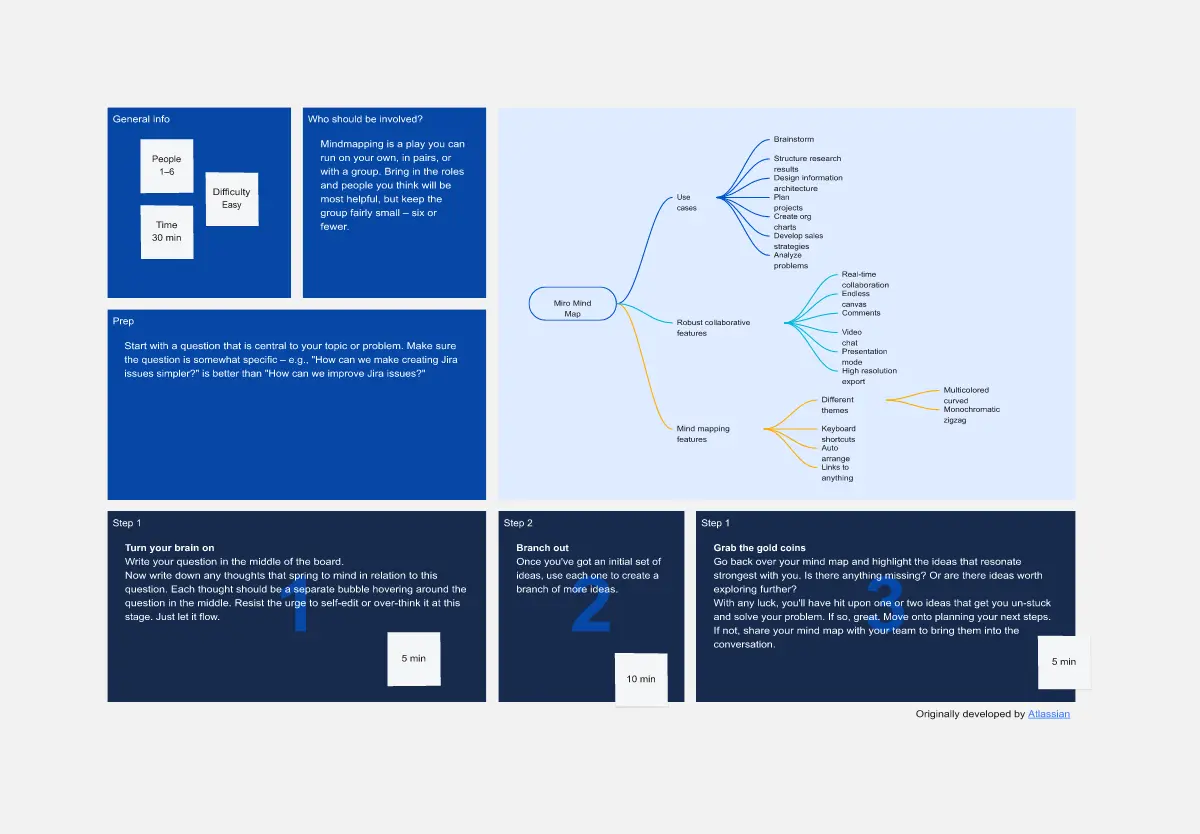
Mindmapping
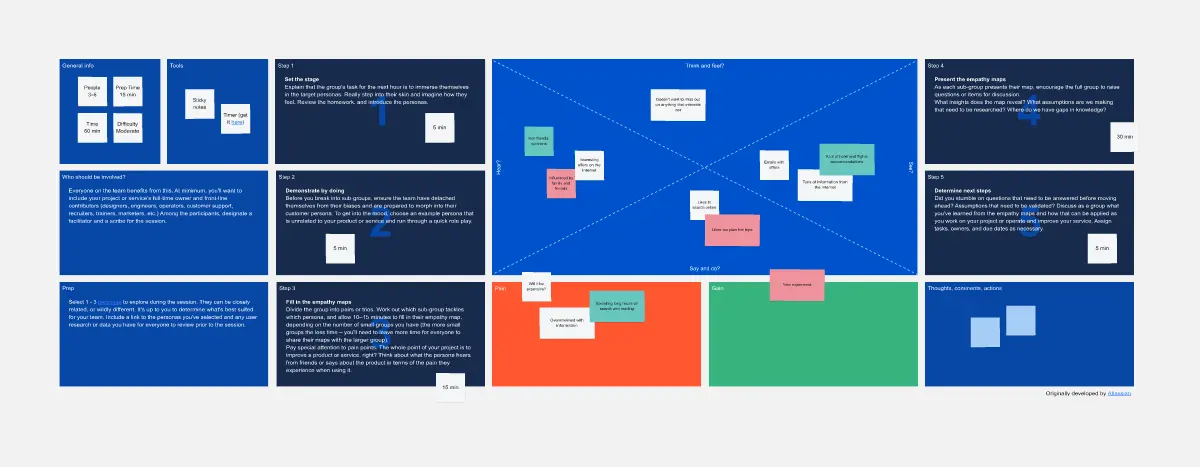
Empathy Mapping
- How to Use This Site
- Usability Testing
- Domain Modeling
Taxonomy Design
- Wireframing
- Accessibility Evaluation
- Journey Mapping
- See All Methods A-Z
- Content Strategy
- Information Architecture
- Interaction Design
- Usability Evaluation
- User Research
- Visual Design

Photo by UX Indonesia via Unsplash
Journey Mapping Method
A journey map is a holistic, visual representation of a user’s experience with a product or service over time. Journey maps combine data and insight from other research and discovery methods to provide a detailed description from the user’s point of view of steps taken, decisions made, successes, pain points, and emotions felt.
Journey maps help designers understand the user’s motivations and needs at each step of a process, from the earliest earliest phases of researching a product or service all the way through adoption, providing crucial insight for designing solutions that better meet user and business needs. The journey map’s visual and storytelling elements also help it communicate research data and findings to broader audiences within an organization.
Preparation
Journey Mapping is often more effective when it is informed by these complementary methods.

Contextual Interviewing
Observation of users performing tasks in their own environment

Task Analysis
Observe users in action to understand how they perform tasks to achieve goals

Written descriptions of how users will perform tasks with your product or on your website

A specific user's context, motivations, and goals for visiting a website or app

Stakeholder Interviewing
Understanding the perspective and influence of those invested in a project's success

User Interviewing
Understand the tasks and motivations of the user group for whom you are designing
- Define business and user goals Clearly articulate the organizational goals for the product or service, the design and business goals for the mapping exercise, and the goals of the target user the map is to represent.
- Gather research data Effective journey maps are based on qualitative and quantitative data collected across a range of activities. Review and incorporate existing research as you create your journey map, and note where gaps in understanding indicate the need for additional research.
- Identify touchpoints and channels Touchpoints describe what users do and how they do it. Channels describe where the interaction takes place (e.g. website, call center, native app, or in-store).
- Create an Empathy Map Empathy maps describe what users do, think, feel, say, and hear in a given situation. They help you understand and articulate users’ emotional state, and provide the basis for illustrating the peaks and valleys of frustration, anxiety, happiness, etc.
- Sketch the journey Visualize the order in which users exhibit behaviors, use information, make decisions, and feel emotions. Group elements into phases related to the narrative of each user. Integrate touchpoints, channels, empathy insights, and other research to show the user’s course of motion across the timescale as a whole. Include the user’s feelings at each touchpoint.
- Review, refine, and revise Review your draft journey with team members and subject matter experts to gain new insight and integrate new perspectives. Use these to identify additional opportunities to make your journey map more accurate, more expressive of the data, and more useful for the design process. From time to time, evaluate your map to make sure it remains accurate. Revise as necessary to account for evolving research, product development, and user and business needs.
Journey Mapping typically produces insight and solutions focused on these areas:
User Preference
Elements, arrangements, or qualities of experience design that user state or show are valuable to them.
User Behavior
Information about how users currently use a site, service, or resource.
Journey Mapping Resources

10 most interesting examples of Customer Journey Maps

7 Interesting Real Life Customer Journey Map Examples

Customer journey maps for content: Untangle complex insights and create better experiences

144 Best Customer Journey Map Templates and Examples

Category Design
Creating structures and schemes that make the location and use of content clear

Persona Creation
Development of research-informed representations of target user goals, behaviors, and pain points

Style Tile Creation
Communicate the use of fonts, colors, and interface elements in a design system

Define a system for labeling and classifying content to make it easier to find, understand, and use
Journey Mapping Method details last edited on Sunday, February 6, 2022
- Find a Library
- Browse Collections
- The Journey Mapping Playbook
ebook ∣ A Practical Guide to Preparing, Facilitating and Unlocking the Value of Customer Journey Mapping · De Gruyter Business Playbooks
By jerry angrave.
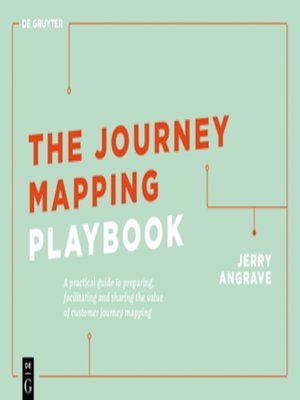
Add Book To Favorites
Is this your library?
Sign up to save your library.
With an OverDrive account, you can save your favorite libraries for at-a-glance information about availability. Find out more about OverDrive accounts.
De Gruyter Business Playbooks
Jerry Angrave
30 September 2020
Find this title in Libby, the library reading app by OverDrive.

Search for a digital library with this title
Title found at these libraries:.
- Artificial Intelligence
- Generative AI
- Business Operations
- Cloud Computing
- Data Center
- Data Management
- Emerging Technology
- Enterprise Applications
- IT Leadership
- Digital Transformation
- IT Strategy
- IT Management
- Diversity and Inclusion
- IT Operations
- Project Management
- Software Development
- Vendors and Providers
- Enterprise Buyer’s Guides
- United States
- Middle East
- Italia (Italy)
- Netherlands
- United Kingdom
- New Zealand
- Data Analytics & AI
- Newsletters
- Foundry Careers
- Terms of Service
- Privacy Policy
- Cookie Policy
- Copyright Notice
- Member Preferences
- About AdChoices
- Your California Privacy Rights
Our Network
- Computerworld
- Network World
The customer journey map: A new playbook CIOs must master
Cios driving digital business strategy must master customer experience. that means working with marketing on a critical initiative: the customer journey map..

The digital era has altered C-suite dynamics. Once unlikely collaborators, IT and marketing are partnering closely on new customer-facing technologies, an acknowledgment that both parties must work together to help their companies — and careers — thrive.
CIOs are also huddling with CMOs and other business line leaders on “customer journey maps,” critical documents that outline key customer touchpoints. Here’s what CIOs should know about customer journey maps and how to ensure you’re making effective use of them.
What is a customer journey map?
The customer journey map includes a chart that helps employees visualize the process by which companies attract customers and inspire loyalty. Journey mapping enables companies to identify touchpoints, find previously unknown problems and their root causes, quantify the value of improving customer experience (CX) through KPIs or other metrics, and measure improvements.
“Journey maps can also help organizations build empathy for customers by walking participants through how touchpoints influence customers’ attitudes and actions,” according to a guide to journey mapping Forrester Research published in August. This enforces customer-centric thinking and encourages good CX behaviors.
10 steps for crafting an effective journey map
The map is created in a collaborative process that relies on qualitative and quantitative data to determine and understand customer journeys, including customers’ goals, needs and expectations, Gartner analyst Jane-Anne Mennella tells CIO.com. The map also helps executives identify gaps between customers’ expectations and their experience during their journey.
Form a cross-functional team. Assemble key stakeholders from business lines, including sales, marketing, IT, operations and human resources. This team will inform and shape the map to ensure it provides a 360-degree view of customers’ desires, Mennella says. “Customer experience is a cross-functional mandate” requiring stakeholders from every business line, but especially the CIO, she says. Ideally, the CEO will govern this group, but Mennella says the CMO or CIO could lead it as well. Regardless, the leader must be “empowered to break any ties,” Mennella says.
Build personas. Craft a “persona,” or an image of the ideal customer, Mennella says. Using this outside-in view of molding digital experiences around the customer, the team should be able to build maps that detail touchpoints, interests and feelings for each persona. Different customer demographics may require different personas.
Pick your methodology. Familiarize yourself with the framing of a journey map and choose a methodology that matches project objectives, says Forrester.
Conduct research. “Listen” to social media to see what people are saying about your brand and tailor services accordingly, Mennella says. Peruse your company’s digital channels, as well as forums and online communities. Operational and transactional data are also key. “We’re seeing this increased focus on customer insights and user research,” Mennella says. The CIO is crucial here, providing customer analytics to help keep the business on a straight path to the customer. Conducting customer research helps identify and eliminate gaps in customer misunderstandings, Forrester says.
Tool up. Use a journey atlas to help visualize and organize the map. Prioritize based on customer and business value. The atlas can show how journeys interrelate, overlap and influence each other, Forrester says.
Workshop for empathy. Co-creation with stakeholders and customers ensures buy-in and validation, Forrester says. Engage in storytelling activities to get to the root of customer behavior and identify moments of truth and areas of improvement.
Correct errors. Journey mapping efforts often fail due to lack of executive buy-in or even mapping the wrong things, Forrester observes. Avoid these pitfalls by including customers as well as the right stakeholders needed to ensure the journey maps are valid.
Select KPIs. Pick metrics that matter most for customer obsession. Start by inventorying existing metrics, having your cross-functional team agree on metrics to eliminate, gaps to fill, and a data collection strategy to implement, Forrester says.
Mine data for richer insights. Journey analytics mines quantitative and qualitative data, such as customer feedback surveys, marketing data and language patterns, Forrester says. This data, ideally collected at every step of the journey, can be combined with web analytics and call center data to hypothesize how changes will improve experiences overall, thereby predicting and optimizing next best actions.
In the absence of such data, Mennella says that hypothetical journey maps are acceptable. Here, an organization outlines the steps, thoughts, feelings and actions they think their customers would take, for example, with a new mobile ordering app.
CIOs shared their customer journey map successes with CIO.com.
Customer journey map examples: Suez North America
Homeowners expect water to simply flow when they turn on a faucet. But in an era defined by Amazon.com’s frictionless and often white-glove service, utility companies realize that many consumers expect more compelling services — even from a utility.
Suez North America’s customer journey maps notes the channels, including smart and analog meters, phone, social media, Web and mobile device channels, that connect the company to consumers, says Michael Salas, CIO and CDO for the water utility, which services 7.2 million residents in New York, New Jersey, Delaware and Rhode Island.
Suez took customer “pulse” surveys, conducted on-site observations and convened workshops in which business and IT conceptualized an ideal utility experience complete with gap analysis, personas and considerations for emerging technologies such as IoT and ML.
Salas says Suez built a customer experience portal for which thousands of customers signed up to make direct debit subscriptions online, automating bill payments and reducing employee hours by the thousands. It also augmented its contact center solution with natural language processing speech recognition, resulting in a self-service rate of 40 percent.
Suez also crafted an Amazon.com Alexa skill to enable consumers to “ask” questions about bill payment and other services without waiting to speak to a human representative. “A voice assistant is a natural interface for our services,” Salas says.
Feedback mechanisms built into this journey map helped Suez further improve service, says Salas, who leveraged agile development with daily standup meetings and Objectives and Key Results (OKRs) , complete with a comprehensive change management program. “We try to put ourselves in the shoes of the customer,” says Salas, who appointed a dedicated director of customer experience, Douwe Busschops, to lead these efforts.
One of the hallmarks of the improved service is pairing better customer services and empathy. For example, smart meters, acoustic sensors and machine learning software generate actionable alerts about water waste, such as water leaks in residents’ homes. These efforts are critical for providing “cradle to grave” service to customers, Salas says.
Customer journey map examples: Adobe
Charting the customer journey proved pivotal for Adobe, which has spent the past several years pivoting from licensed software to SaaS (software-as-a-service) sales models.
To better understand customer behavior, Adobe tracks product downloads, display ad impressions, click-through rates for Adobe.com and various other signals consumers initiate online as they try, buy, use and renew software, says Mark Picone, vice president of information and data services. Tracking revenue and product consumption, including cancellations, by geography is also a key task for Adobe, which uses the information to determine whether to increase promotions and perks in certain regions, he adds.
This approach to examining customer behavior makes it easier to personalize email campaigns for consumers, a key marketing practice for Adobe. “We look at all of those events and petabytes of click-level instrumentation of how consumers are using products,” Picone tells CIO.com, adding that Adobe also created key performance indicators to monitor progress.
Information about how people consume Adobe software is also critical, Picone says, because it informs product teams how to refine software for customers.
To build a unified data architecture that enables these capabilities Adobe “normalized,” or consistently defined, and labeled each data type. The challenge? The same data types are often called different things by finance, sales, marketing and other business lines — a common challenge most enterprise face as they seek to streamline data governance.
Customer journey map mistakes to avoid
Building a customer journey map is one thing; leveraging it to bolster the customer experience is another. While 77 percent of 244 marketing leaders Gartner surveyed said they have a journey map, 30 percent struggle to use them effectively in support of their customer experience efforts, Mennella says. Here are some common pitfalls CIOs and their colleagues should avoid:
You have to start somewhere. Journey maps often fall down because organizations don’t know where to start, typically because they don’t know the customers they are targeting. Mennella says enterprises sometimes rely too much on third-party data, which puts distance between them and their customers. Here, Mennella says analytics and usage metrics can help hone your personas and goals.
Beware the product management pitfall. Sometimes enterprises are too focused on their own goals rather than what their customers need, Mennella says. Start with the outside-in approach, rather than simply building a product you think people want and trying to sell it to them.
Some customers are more valuable than others. Sometimes organizations focus on the easy, low-hanging fruit personas. Go for the big whales that are going to be loyal advocates who bring fellow customers on board to keep the flywheel spinning.
Related content
Appeal court overturns $1.6bn mainframe software ‘poaching’ ruling against ibm, ibm and aws forge global alliance, streamlining access to ai and hybrid cloud solutions, ups delivers customer wins with generative ai, scrum master certification: top 13 certs for agile pros, from our editors straight to your inbox, show me more, why your business needs a cloud-based print management solution.

The cyber pandemic: AI deepfakes and the future of security and identity verification

Transform the modern data center: From today to the future

CIO Leadership Live Australia with Geoff Quattromani, Head of Technology, Johnson & Johnson MedTech ANZ

CIO Leadership Live Middle East with Ahmed Wattar, Group Information Technology Director at Alfa Medical Group

CIO Leadership Live Middle East with Dr. Mohammad Alshehri, CISO and Cybersecurity Consultant

The Great AGI Question: When, How and What Does It All Mean?

How Does GenAI Fit into the Enterprise?

Sponsored Links
- Everybody's ready for AI except your data. Unlock the power of AI with Informatica
Did you know?
Companies with happy employees outperform the competition by 20%? ( Snacknation, 2024 )
At HubSpot we take pride in our Culture Code , because we see our culture as an extension to our product line.
Looking for ways to expand your tech stack? Check out HubSpot’s collection of customer service apps.
Customer Journey Map Template
Chart your CX landscape and enhance interactions at every touchpoint using our customer journey templates.
How to Develop a Unified CX Strategy
The post-sale playbook.
A unified CX strategy involves breaking down silos between marketing, sales, customer service, and other departments to ensure consistent messaging, personalized experiences, and efficient problem resolution. By focusing on delivering a cohesive and integrated experience to customers at every stage of their journey, businesses can differentiate themselves in a competitive market and build a loyal customer base.
Core Components to Any CX Strategy
Crafting an exceptional customer experience (CX) strategy requires weaving together key elements that cater to customers' needs and preferences seamlessly. It all starts with customer understanding – the cornerstone of creating experiences that deeply connect with individuals on a personal level. In today's fast-moving digital world, omni-channel integration is a must. Customers expect a smooth journey across all touchpoints, whether they're browsing online, engaging on social media, or stepping into a physical store. By blending these channels seamlessly, organizations can ensure a unified and hassle-free experience for customers at every turn. Empowering employees is crucial for delivering standout customer experiences. Engaged team members , well-versed in a customer-centric mindset , are the driving force behind exceptional service that goes above and beyond. Investing in their growth and nurturing a culture that values customer satisfaction is key to elevating service quality.
A two-way feedback loop is essential for staying in tune with customer needs. Listening directly to their insights in real-time allows organizations to swiftly address issues, adapt to changing preferences, and continually refine the CX strategy to meet evolving customer expectations.
And let's not forget about measurement and metrics – the compass guiding the CX strategy. By tracking key indicators like customer satisfaction scores and retention rates , organizations gain valuable insights into customer sentiment, identify areas for improvement, and make informed decisions to enhance the overall customer journey.
When these components work together harmoniously, they form the bedrock of an outstanding CX strategy that doesn't just meet customer needs but anticipates and exceeds them. It's through genuine customer-centricity, seamless integration, engaged teams, active feedback, and strategic measurement that organizations can elevate the customer experience to new heights and drive lasting success.
The Cost of an “All-On-None” Platform
Imagine a powerful all-in-one platform that streamlines your CX strategy by consolidating critical data in a single repository. This integrated approach lays a robust framework for amplifying customer satisfaction and fostering brand loyalty. That’s one reason why HubSpot customers with Sales, Marketing and Service Hub Professional see their deal close rate increase after 6 (61%) and 12 (95%) months ( Source ). On the other hand, a fragmented “all-on-none” system may lead to inconsistent customer experiences that may pose risks to satisfaction levels and customer retention. The fragmentation of data and insights within disconnected systems can lead to revenue leakage and hinder market competitiveness. Moreover, the lack of seamless communication among teams may result in delays in addressing customer issues effectively. Anyone who has had to repeat basic information to multiple support agents with each handoff can understand the frustration of siloed data.
All-in-one systems give organizations the benefit of cross object automation and shared reporting . For example, imagine your Marketing department was running a referrals campaign and they wanted to ask their happiest customers for testimonials. Instead of being dependent on the Customer Experience department for a list of happy customers, they could utilize automation to trigger an internal notification any time a customer submitted an NPS score of 9 or 10. On the flip side, imagine a situation without the benefit of an all-in-one platform. A Customer Success Manager identifies a great cross-sell opportunity after one of their regularly scheduled customer calls and they create a sales qualified lead so the Sales team can follow up and share more in-depth pricing and packaging information with the client. They create the SQL in their Customer Success Platform and an integration sends that lead over to their company’s CRM for the Sales Rep. Unfortunately though, data hygiene isn’t great and that lead never gets assigned to anyone. The customer has lost out on learning more about a feature that could help them grow their business and the organization has lost a potential sale. By harnessing the strengths of unified platforms while mitigating the pitfalls of fragmented tools, businesses can deliver exceptional post-sale experiences that exceed customer expectations and empower teams to excel.
HubSpot’s Service Hub
In the realm of customer service excellence, Service Hub emerges as a powerful tool to elevate the entire customer journey – from pre-purchase engagement to post-purchase satisfaction. One standout feature is the omni-channel Help Desk , a versatile tool that allows businesses to scale their support operations seamlessly across multiple communication channels. Dedicated to help post-sale support roles, the Help Desk ensures a consistent support experience that resonates with customers at every touchpoint. Time is of the essence in customer service, and Service Hub helps businesses improve both their time to first response and time to resolution with capacity and skills-based routing capabilities . These features enable businesses to optimize response efficiency by promptly directing customer queries to the most suitable team members. They can ensure agents don't get overloaded with too many tickets by setting a limit with capacity routing. And for organizations who want to ensure the customer is being connected with the right support agent the first time, they can use skill-based routing. Skills can be defined by the organization and can include language, tier level of support, function (billing v. product), and more.
By streamlining the response process, businesses can not only improve operational efficiency but also cultivate trust and satisfaction with their customers through timely resolutions. Beyond being reactive, Service Hub enables businesses to take a proactive approach to customer success by providing tools to monitor customers and issue resolutions in real-time . This capability allows businesses to stay ahead of customer needs, identify potential issues before they escalate, and maintain a level of service that is tailored to meet evolving customer preferences. Additionally, the seamless integration of customer feedback sharing with marketing and sales teams promotes cross-departmental collaboration, aligning strategies to provide a unified and customer-centric approach to support. With predictive analytics, personalized interactions, targeted communication, and customized dashboards, Service Hub equips businesses with a versatile toolkit to create tailored and exceptional post-sale experiences that delight customers and drive long-term retention and loyalty .
With Backstage, Spotify’s getting serious about its enterprise and dev tools business play
Music-streaming giant takes a cue from red hat's open source playbook with enterprise support and services.

You know that mildly jarring experience whenever that well-known celebrity shows up in an entirely different context — e.g. a musician making a horror flick cameo ; an NFL player rearing their head in a comedy series; or a Hollywood movie icon selling mobile phone plans on TV? Well, it’s starting to feel like that with Spotify’s foray into the enterprise and developer tooling space — nothing wrong with it per se, but it makes you flinch just a little due to its divergence from the norm.
What we’re talking about is Backstage , a platform and framework Spotify introduced internally in 2016 to bring order to its developer infrastructure. Backstage powers customizable “developer portals” that combine tooling, apps, data, services, APIs and documents in a single interface. Want to monitor Kubernetes, check your CI/CD status or track security incidents? Backstage to the rescue.
Lots of companies construct their own internal systems to help developers work more efficiently. And lots of companies release such systems to the public via an open source license to spur wider adoption, as Spotify did with Backstage in 2020 . But it’s highly unusual for a consumer technology company to actively monetize this side of its business, which Spotify has been doing since 2022 .
Now, Spotify is leaning even further into this play with the launch of a new suite of products and services designed to make Backstage the de facto developer portal platform for the software development industry.
Spotify’s grand plan to monetize developers via its open source Backstage project
Backstage is built on a modular, plug-in based architecture that allows engineers to layer-up their developer portal to meet their own needs. There is already a thriving marketplace for Backstage plug-ins , some developed by Spotify itself and some by the wider community, including developers from Red Hat and Amazon Web Services (AWS) — AWS, for example, has developed a plug-in to make data from Amazon Elastic Container Service ( ECS ) available in Backstage.
Since late 2022, Spotify has been selling a handful of premium plug-ins as a subscription, such as Backstage Insights , which serves up data related to Backstage usage across an organization, including which plugins they’re engaging with most.
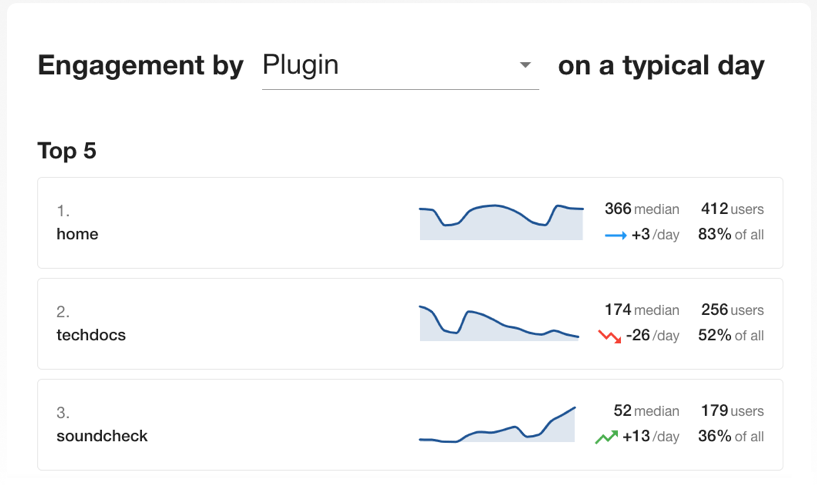
Backstage Insights plug-in. Image Credits: Spotify
The open source Backstage project has been adopted internally by some of the world’s most well-known companies, including LinkedIn, Twilio, American Airlines, Unity, Splunk, Ikea, HP and more than 3,000 organizations. But as with just about any open source project, the main issue with Backstage is the complexity involved in getting set up — lots of integrations, configurations and figuring out how it all glues together.
Thus, Spotify is now introducing an out-the-box version of the open source project called Spotify Portal, available in beta from today, which is pitched as a “full-featured, low-/no-code internal developer portal (IDP)” built atop Backstage.

Spotify Portal. Image Credits: Spotify
Spotify Portal ships with quick-start tools for connecting all their internal services and libraries, replete with setup wizard for installing Portal and connecting it with a company’s GitHub and cloud provider.
“When you set up your IDP, typically you need to ingest a lot of software into that, because the point of the IDP is to capture your full software catalogue and map that to the user base, and there’s potentially a lot of integrations involved in,” Tyson Singer, Spotify’s head of technology and platforms, explained to TechCrunch. “And so with Spotify Portal for Backstage, we’ve basically given folks a no-code way to do that.”
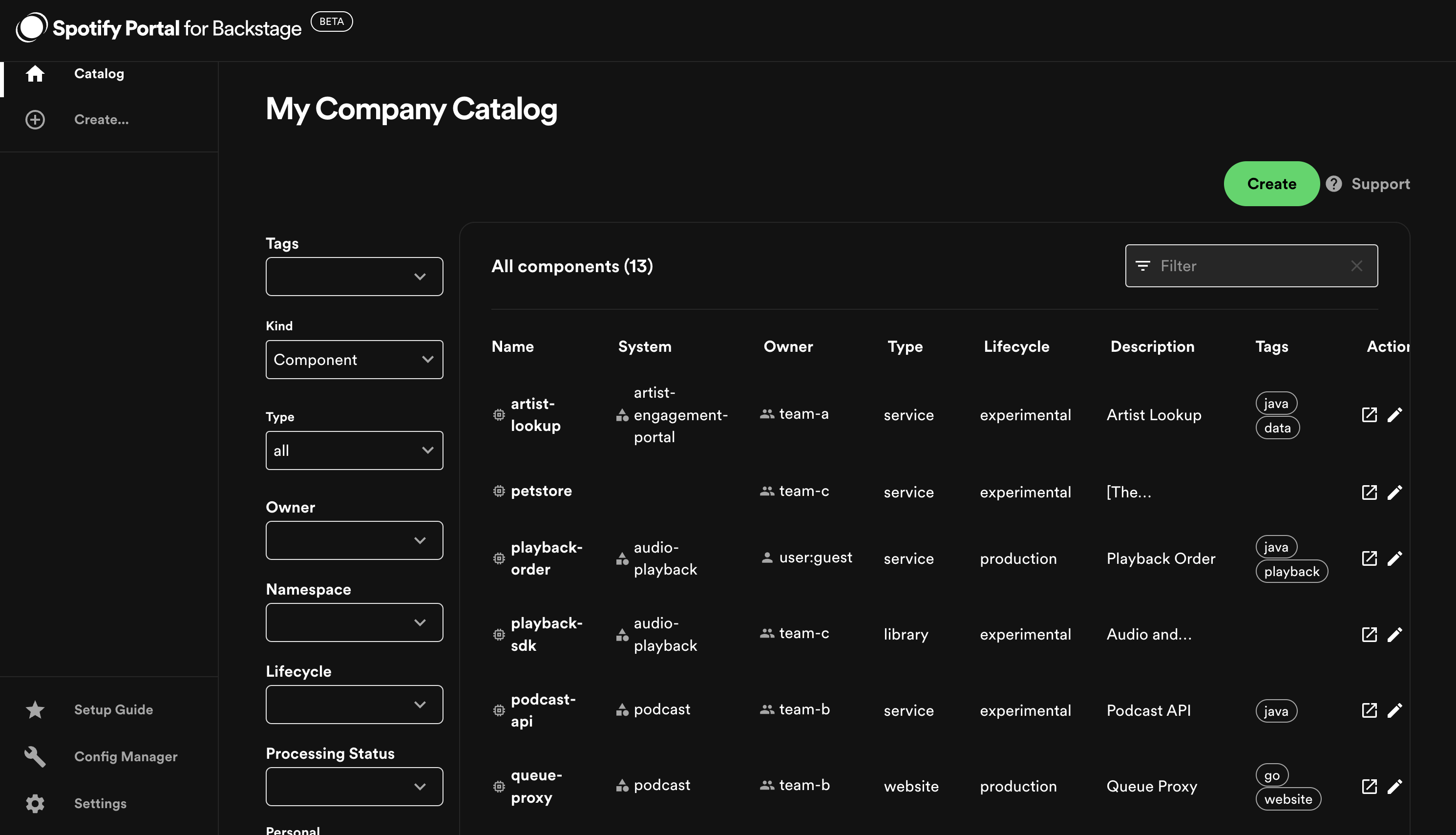
Spotify Portal: Ingesting software catalog. Image Credits: Spotify
Getting SaaS-y?
On the surface, this seems like some sort of SaaS play, similar to how a commercial company might offer a fully managed, hosted version of a popular open source product. But that isn’t quite what’s happening here — there is no hosted element to this, though that might change in the future. It’s what Singer calls “Backstage in a box,” one which is deployed within the customer’s own ecosystem either on-premises, or in their own cloud.
“It’s the customer who manages it,” Singer said. “What’s important from our perspective is that we’ve really focused on both reducing the startup time and the maintenance time. So that means not only is the setup and the onboarding ‘no-code,’ it’s also the maintenance where we’re reducing code. That really makes it quite easy to manage in your own particular context.”
However, in a follow-up question, a Spotify spokesperson clarified that Spotify Portal for Backstage is its “first step towards a managed product,” which means that it more than likely will be offered more like a SaaS service in the future. “We’ve seen a growing appetite for a more managed product that would allow us to share our expertise more directly with companies, and we want to be able to offer more in support of that need,” the spokesperson said. “Portal is our first step on that journey, but in the future, we’re going to expand our offerings as managed.”
In addition, Spotify is adding various enterprise support and services to the mix, which it says it has already been providing since last summer but hasn’t disclosed this until now. This includes one-on-one tech support from dedicated Backstage personnel at Spotify, and includes service-level agreements (SLAs), security reviews and incident notifications. And for those wanting to get up-and-running with Backstage in the first instance, Spotify is also offering consulting services.
Spooling up
In essence, Spotify is now catering to three broad category of users: the core open source project for those with the resources and technical nous to self-deploy everything; the “hybrid adopters,” which is what Spotify calls those that have some of the necessary skills but need some support along the way; and the businesses that need something a bit more oven-baked — which is where Spotify Portal enters the fray.
Similar to the pricing structure for its existing plugin subscriptions, which are charged based on “individual customer parameters” such as usage and capacity, the new Portal and enterprise services don’t come with up-front costs.
“For pricing, we are referring customers back to our sales organization,” Singer said. “It’s custom pricing.”
Given this transition to an enterprise-focused developer tools company, Spotify is also having to staff-up accordingly, though Singer wouldn’t share how many people it would be hiring or allocating to these new support roles.
“We are changing how we go forward with both our sales organization and support,” Singer said. “So we’re shifting more focus towards how can we support customers in their initial journey and then also, once they’ve got it set up, their ongoing journey because we do want to be able to support them to get to value as quickly as possible.”
All this, it seems, is just the tip of the iceberg as far as Spotify’s developer tooling shift is concerned. The company is adding new features to some of its existing premium plug-ins, and it’s adding more plug-ins to the mix, too. One of these is the “data experience” plug-in, which makes it easier to add individual data entities to a software catalog — this includes built-in “ingestors” to scoop metadata from external data platforms, and make this available across Backstage.
Last year, Spotify also teased a totally separate product for software development teams called Confidence , which is like an A/B experimentation platform based on one of its own internal tools. For now, that remains a beta product, but Singer says that it’s “all systems go” as it readies things for prime-time in the future.
“We are super happy with the feedback that we’ve been getting from our [Confidence] beta customers so far,” Singer said. “We built out an experimentation platform that is broad and deep, covering a tremendous amount of use cases covering everything from your typical A/B testing on a user surface, to being able to do that across all of our ML [machine learning] use cases. And I think that really sets it aside, as more and more companies are using ML in the same sorts of ways that we are to optimize things. “

COMMENTS
Define the map's scope (15 min) Ideally, customer journey mapping focuses on the experience of a single persona in a single scenario with a single goal. Else, the journey map will be too generic, and you'll miss out on opportunities for new insights and questions. You may need to pause creating a customer journey map until you have defined your ...
The Journey Mapping Playbook: A practical guide to preparing, facilitating and unlocking the value of customer journey mapping A valuable guide in helping you build stronger customer experience programmes by developing effective customer experience strategies. Customer journey mapping is a vital tool used by Customer Experience professionals around the world.
The Journey Mapping Playbook: A practical guide to preparing, facilitating andunlocking the value of customer journey mapping A valuable guide in helping you build stronger customer experience programmes by developing effective customer experience strategies. Customer journey mapping is a vital tool used by Customer Experience professionals around the world.
The Journey Mapping Playbook: A Practical Guide to Preparing, Facilitating and Unlocking the Value of Customer Journey Mapping - Ebook written by Jerry Angrave. Read this book using Google Play Books app on your PC, android, iOS devices. Download for offline reading, highlight, bookmark or take notes while you read The Journey Mapping Playbook: A Practical Guide to Preparing, Facilitating and ...
The Journey Mapping Playbook is an accessible how-to-do-it toolkit aimed at customer experience (CX) and marketing professionals who wish to improve their customer and employee experience. Jerry Angrave, a Customer and Passenger Experience Director who works across many sectors, including aviation and travel, financial services, professional ...
The Journey Mapping Playbook: A Practical Guide to Preparing, Facilitating and Unlocking the Value of Customer Journey Mapping De Gruyter Business Playbooks Series: Author: Jerry Angrave: Edition: illustrated: Publisher: De Gruyter, 2020: ISBN: 3110641119, 9783110641110: Length: 156 pages: Subjects
Craig Douglas. March 28, 2024. User journey mapping is a powerful tool that helps businesses understand and improve the customer experience. By visually representing the customer journey, companies can identify key interactions, or touchpoints, where customers engage with their brand. This process involves detailed user research to gather ...
The Journey Mapping A practical guide to preparing, fa… The Journey Mapping Playbook: A Practical Guide to Preparing, Facilitating and Unlocking the Value of Customer Journey Mapping by Jerry Angrave | Goodreads
The Journey Mapping Playbook is an accessible how-to toolkit aimed at customer experience and marketing professionals looking for ways to improve customer and employee experience. Using visualisation, templates and case studies this is a practical guide to planning, facilitating and delivering a strategic, supportive and effective journey mapping workshop.
Key Steps in Journey Mapping. The chart below shows the steps for using a journey map to create a new product or service. Guidelines at the end of this section describe how to use the journey mapping process for an existing product or service. Step 1. Establish the Design Goal for the Product or Service.
The customer journey map is a method to gain useful customer insights by laying out the steps a user takes, along with a series of touch points and feelings your customer has towards your service or product. Conducting a customer journey mapping workshop does a few key things. It facilitates a common understanding between team members, uncovers ...
The Journey Mapping Playbook A Practical Guide to Preparing, Facilitating and Unlocking the Value of Customer Journey Mapping. Jerry Angrave
2. Senior Designer Bundle: Become a design leader with systems to help you build a meaningful career & grow your designers. Join 500+ aspiring leaders. 3. UX Portfolio Critique: Get a 20-minute video review of your portfolio. A checklist of actionable things to fix, in less than 48 hours. Get a personalised portfolio critique here.
Step 2: Build a back-story. 10 min. Have the group use sticky notes to post up reasons why your target persona would be on this journey in the first place. Odds are, you'll get a range of responses: everything from high-level goals, to pain points, to requested features or services. Group similar ideas and groom the stickies so you can design a ...
The Journey Mapping Playbook is a practical guide, presented in striking colour, with downloadable worksheets and frameworks to help you prepare, plan and run your workshop. Events around the book. Access to over 1 million titles for a fair monthly price. Study more efficiently using our study tools.
The Journey Mapping Playbook: A Practical Guide to Preparing, Facilitating and Sharing the Value of Customer Journey Mapping. ... Journey mapping is a hugely versatile tool that will benefit any organisation of any size and complexity. It can be used to establish the starting point; a common understanding of what today's experience is really ...
The Journey Mapping Playbook: A Practical Guide to Preparing, Facilitating and Unlocking the Value of Customer Journey Mapping 1st Edition is written by Jerry Angrave and published by De Gruyter. The Digital and eTextbook ISBNs for The Journey Mapping Playbook are 9783110641332, 311064133X and the print ISBNs are 9783110641110, 3110641119. ...
A customer journey map visualizes the entire journey through a user's perspective and creates consensus on what problems to . ... UX Playbook Playbooks to Navigate UX Careers ⚡️ Published Oct ...
A journey map is a holistic, visual representation of a user's experience with a product or service over time. Journey maps combine data and insight from other research and discovery methods to provide a detailed description from the user's point of view of steps taken, decisions made, successes, pain points, and emotions felt.
The Journey Mapping Playbook is an accessible how-to-do-it toolkit aimed at customer experience (CX) and marketing professionals who wish to improve their customer and employee experience. Jerry Angrave, a Customer and Passenger Experience Director who works across many sectors, including aviation and travel, financial services, professional ...
10 steps for crafting an effective journey map. The map is created in a collaborative process that relies on qualitative and quantitative data to determine and understand customer journeys ...
Jerry Angrave (author of 'The Journey Mapping Playbook' and founder & CEO of Empathyce, UK) introduces to his new book 'The Journey Mapping Playbook'.Learn m...
Customer Experience Playbook 2 Customer Experience (CX) is not new; industry has been doing CX for a long time. Agencies ... Develop a customer journey map for your program/service, including activities and touchpoints with your agency. Highlighting pain points, points of delight, moments of truth, and the customer's emotional state. ...
In the realm of customer service excellence, Service Hub emerges as a powerful tool to elevate the entire customer journey - from pre-purchase engagement to post-purchase satisfaction. One standout feature is the omni-channel Help Desk , a versatile tool that allows businesses to scale their support operations seamlessly across multiple ...
With Backstage, Spotify's getting serious about its enterprise and dev tools business play Music-streaming giant takes a cue from Red Hat's open source playbook with enterprise support and services